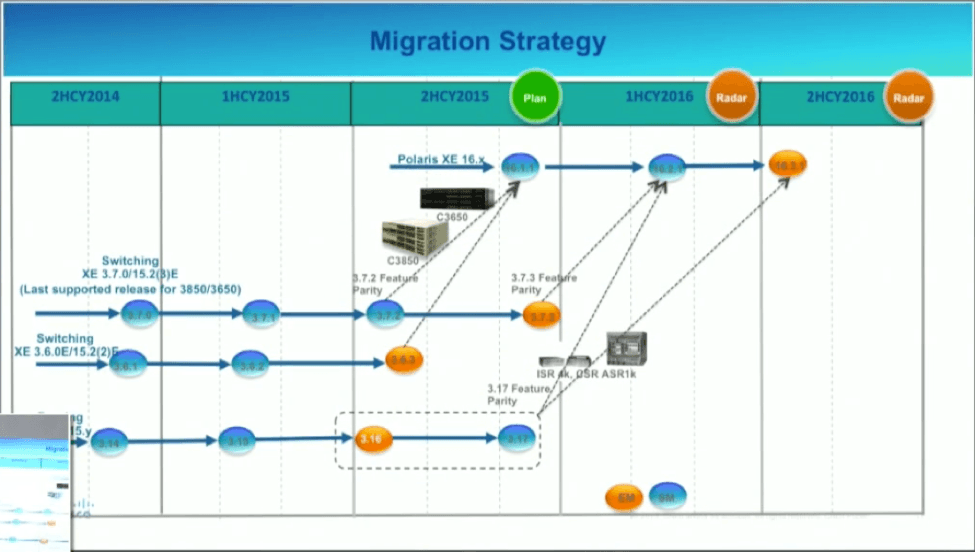Cisco had an interesting and very promising presentation at Network Field Day 11 about an effort to unify their codebase for a part of their product line. Jagbir Kang, product manager for enterprise switching, provided an overview of the IOS XE Denali (16.1.1) release which will unify the development trains for the Cat 3850 and 3650 switches with the ASR1000 routing platform. Tracking feature and bug sets within each code train has been a big pain point for customers. The code train diagram below shows the migration path to get to a single release (16.1.1, which came out in March 2016).

History buffs may be interested to know that Cisco’s code releases in the early days were all from a single codebase. The AGS, MGS, and CGS all ran the same code – actually, the same binaries. All functions existed in one release, even for disparate products. It was possible to install a terminal server card in a router and run it as a “trouter,” or terminal-server-router, albeit with reduced performance for both functions. For me, that was a déjà vu moment.
It takes a lot of effort to get multiple product teams to work from the same codebase. But there are numerous advantages in terms of lower support costs and faster customer deployments. They are going to use a hardware abstraction layer under the main codebase to interface to the specific hardware functionality.
Of course, not everything will translate to the existing hardware. There will be some functions that can’t be supported on some platforms. While the binaries will be different, they will be built from the same codebase, ensuring consistency of the released feature sets. I’m hopeful that this project will work out well. Check the release notes for exceptions to feature consistency across the platforms.
Surprising Building Infrastructure
The big surprises to me were the changes in building infrastructure, presented by Himanshu Mehra, Product Manager, Enterprise Switching. There wasn’t any surprise in building infrastructure control; that’s been going on for some time. What caught me by surprise was building lighting over PoE.
Building lighting has traditionally been powered from the building AC power mains, with switches at the entrances to rooms. Sensor switches that detect room presence have been used for many years to automatically turn off lights in unoccupied rooms. (A paper, Managing Energy Costs in Office Buildings, says that 39% of office building electrical costs are due to lighting. In comparison, residential lighting was 14%, or 150 Billion KWH, according to the US Energy Information Administration.)
I hadn’t thought about running lighting over PoE infrastructure due to the loss in the relatively small gauge wires in Cat 6 cabling. But there is a lot more wire (read: expense) in running high-voltage AC wiring just for low-current LED lighting. There’s the cost of the wire itself and the cost of the installation, including manufacturing the wire, getting it to the job site, and running a wire segment to the wall switch. There’s also the inefficiency of converting high voltage (120v in the US, 220v overseas) into the voltages that LED lighting can use.
That’s where running LED lighting over PoE comes in.
PoE is nominally 48v and the 802.3af spec supports 15.4W while the newer 802.3at spec supports 25.5W. The latter spec also prevents using all four pairs for power, protecting electronics from being fried if connected to a lighting cable.
Well, 25W is enough to produce some good lighting with high efficiency LEDs. It is also possible to do a lot more interesting things with remote control of lighting, including reducing lighting when ambient light from outdoors reduces the need. Another interesting artifact of this technology is that the control system can be centralized instead of distributed, as has been historically done, if there was any control other than a light switch.
Welcome to the merger of network PoE and LED lighting. Very cool!
